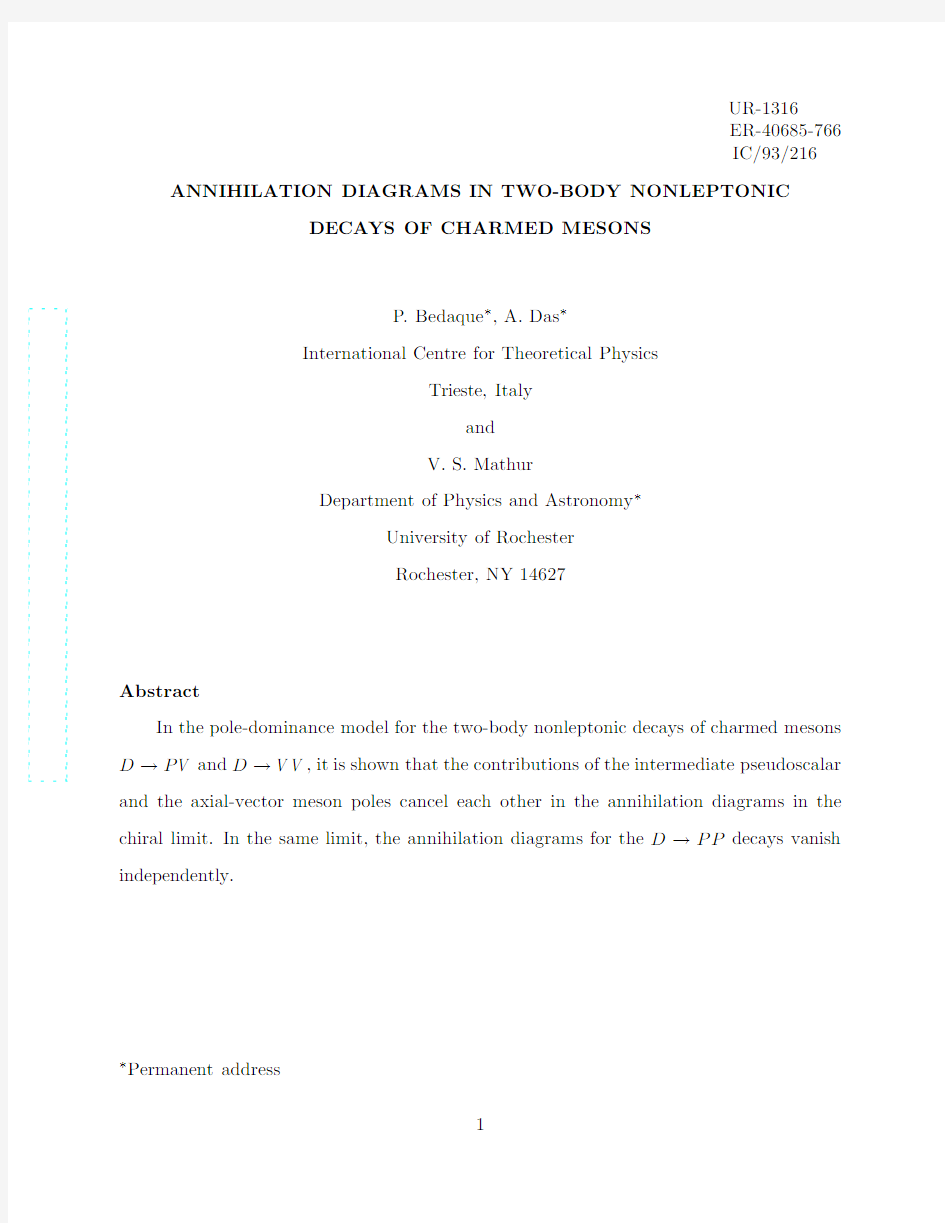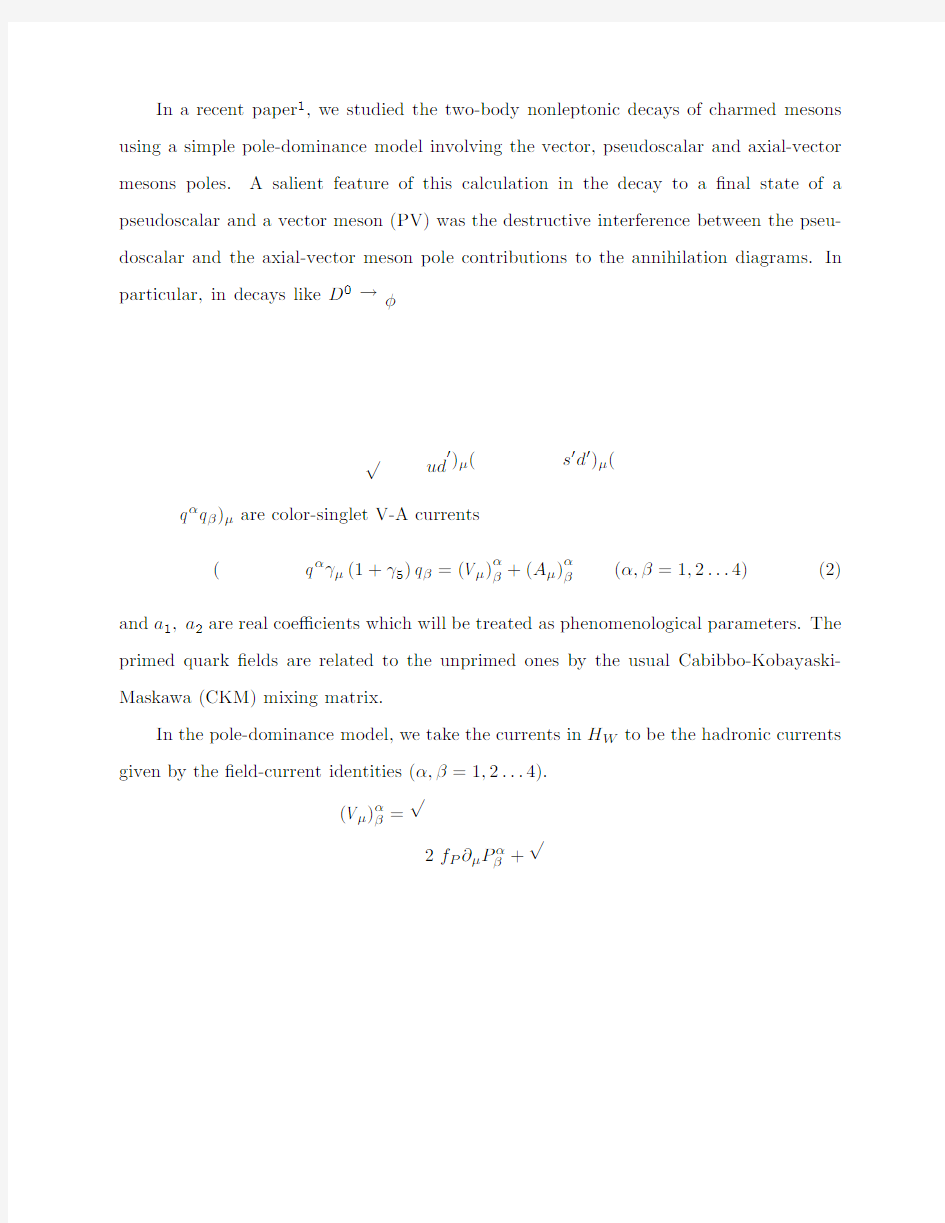

a r X i v :h e p -p h /9309247v 1 9 S e p 1993UR-1316
ER-40685-766
IC/93/216
ANNIHILATION DIAGRAMS IN TWO-BODY NONLEPTONIC
DECAYS OF CHARMED MESONS
P.Bedaque ?,A.Das ?International Centre for Theoretical Physics Trieste,Italy and V.S.Mathur Department of Physics and Astronomy ?University of Rochester Rochester,NY 14627Abstract In the pole-dominance model for the two-body nonleptonic decays of charmed mesons D →P V and D →V V ,it is shown that the contributions of the intermediate pseudoscalar
and the axial-vector meson poles cancel each other in the annihilation diagrams in the chiral limit.In the same limit,the annihilation diagrams for the D →P P decays vanish independently.
?Permanent address
In a recent paper1,we studied the two-body nonleptonic decays of charmed mesons using a simple pole-dominance model involving the vector,pseudoscalar and axial-vector mesons poles.A salient feature of this calculation in the decay to a?nal state of a pseudoscalar and a vector meson(PV)was the destructive interference between the pseu-doscalar and the axial-vector meson pole contributions to the annihilation diagrams.In particular,in decays like D0→φ
√ud′)μ(s′d′)μ(
qαqβ)μare color-singlet V-A currents
(qαγμ(1+γ5)qβ=(Vμ)α
β+(Aμ)α
β
(α,β=1,2...4)(2)
and a1,a2are real coe?cients which will be treated as phenomenological parameters.The primed quark?elds are related to the unprimed ones by the usual Cabibbo-Kobayaski-Maskawa(CKM)mixing matrix.
In the pole-dominance model,we take the currents in H W to be the hadronic currents given by the?eld-current identities(α,β=1,2...4).
(Vμ)αβ=
√
2f P?μPαβ+
√
pseudoscalar and axial-vector meson poles can contribute only to D→P V and D→V V, but not to D→P P.In Figs.1and2,we display these contributions to the annihilation-type Feynman diagrams for D→P V and D→V V,respectively.In these?gures,the dark dot represents the weak vertex and the open circle the strong vertex.Also the dotted,solid and wavy lines represent the pseudoscalar,vector and axial-vector mesons,respectively.
The strong vertices appearing in Figs.1and2are of the type V P P,V P A,V V P and V V A.As in ref.1,we use an extended spin-SU(4)symmetry to relate the V V P couplings to the V P P couplings.In fact we use a generalization of the Sakita-Wali interaction Hamiltonian4,which relates the V P P,V V P and V V V couplings
H str=ig Tr φμP←→?μP?2
Fμνφμφν?2
3
Fμν[P,F aμν]?
4M
?1
Now,the coupling constants g and g′can be related through chiral symmetry.The simplest way to see this is to consider the matrix element of an axial-vector current between an ordinary vector and an ordinary pseudoscalar meson
iεVν(p)
q2+m2A 1+1
2M
g A g′
q2+
2M
q2+m2A 1?m2A
m2
A
Mg′=0(10)
Returning to the decays D→P V and D→V V,we de?ne the decay amplitudes as follows
M(D(q)→V1(q1,λ1)P2(q2))=?i(2π)4δ(4)(q?q1?q2)
2q0V2q10V2q20V
q2·ε(λ1)(q1)B(11)
M D(q)→V1(q1,λ1)V2(q2,λ2) =?i(2π)4δ(4)(q?q1?q2)
2q0V2q10V2q20V
iCδαβ+iDεμανβq1μq2ν+iEq1βq2α ε(λ1)α(q1)ε(λ2)β(q2)(12) The contributions of the pseudoscalar and axial-vector meson poles to the annihilation diagrams in Fig.1for the decay D→P V are easily calculated to be
B ann(P)=?4αa f D f P m2
D
m2
A Mg′
(13)
where a stands for the coe?cient a1or a2in the weak Hamiltonian(1),depending on which term in(1)contributes,and
α=G F
2
V?cs V ud(14)
In(14),the V’s represent the matrix elements of the CKM matrix.Here we are considering the Cabibbo allowed decays,but the considerations can be readily extended to the Cabibbo suppressed decays also.Note that in Fig.1,P is an ordinary pseudoscalar meson,so that in the chiral limit with m P→0,we get from(13),on using the result(10)
B ann(P)+B ann(A)=0(15)
Thus,in the chiral limit,the pseudoscalar and axial-vector meson pole terms cancel each other in the annihilation diagrams of the decay D→P V.
For the decay D→V V,we similarly?nd the contributions of the pseudoscalar and axial-vector meson poles to the annihilation diagrams in Fig.2to be
C ann(P)=E ann(P)=0
D ann(P)=4αa f D f P m2D
M
C ann(A)=E ann(A)=0
D ann(A)=?2αa f D
g A
Once again in the chiral limit,we?nd on using(10)
D ann(P)+D ann(A)=0(17)
Thus,in the chiral limit,the pseudoscalar and axial-vector meson pole contributions to the annihilation diagrams in D→V V also cancel each other.
It should also be noted that in the decay D→P1P2,where only the vector meson pole contributions,the annihilation diagram also vanishes in the chiral limit.This is easily seem from the result5
A ann∝m22?m21
Using(10),we?nd g′=?6.5,which gives
Γ(A1→ρπ)=566MeV(19) Experimentally,this width is not well-determined but our result may be compared with the value quoted in the particle properties data booklet6of~400MeV. Acknowledgement
This work was supported in part by the U.S.Department of Energy Grant No.DE-FG-02-91ER40685.
References and Footnotes
1.P.Bedaque,A.Das and V.S.Mathur,University of Rochester preprint no.UR-1314
(1993).
2.K.Jagannathan and V.S.Mathur,Nucl.Phys.B171,78(1980).
3.M.Bauer,B.Stech and M.Wirbel,Z.Phys.C-Particles and Fields34,103(1987).
4.B.Sakita and K.C.Wali,Phys.Rev.Lett.14,404(1965)and Phys.Rev.139,
B1355(1965);A.Salaam,R.Delbourgo and J.Strathdee,Proc.Roy.Soc.(London) 284,146(1965).
5.A.Das and V.S.Mathur,Mod.Phys.Lett.A8,2079(1993).Note that(18)also
vanishes in the SU(3)symmetric limit.
6.Review of Particle Properties,Phys.Rev.D45,Part2(June1992).
Figure Captions
Fig.1Feynman diagrams for the pseudoscalar and axial-vector meson pole contributions to the annihilation amplitude in the decay D→P V.
Fig.2Feynman diagrams for the pseudoscalar and axial-vector meson meson pole contribu-tions to the annihilation amplitude in the decay D→V V.
Fig.3Feynman diagrams for the pseudoscalar and axial-vector meson pole contributions to the form-factors in Eq.(7).